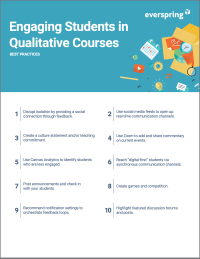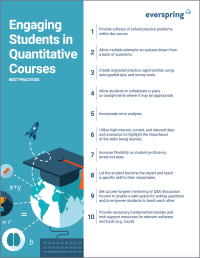Search
There are 53 results.
Category
Tag
Tag
All (53)
Analytics (4)
Assessments (7)
Asynchrony (3)
Belonging (2)
Canvas (6)
Case Studies (1)
Collaboration (3)
Communication (8)
Community (5)
Content Creation (1)
Course Maintenance (1)
Course Preparation (3)
Discussions (4)
Diversity (2)
Faculty Presence (9)
Faculty Support (3)
Feedback (5)
Formative Assessments (1)
Generative AI (1)
Grading (8)
Inclusion (4)
Learning Objectives (1)
Multimodality (4)
Peer Review (1)
Presentations (1)
Qualitative courses (1)
Quantitative courses (1)
Revision (1)
Rubrics (1)
Social Media (2)
Synchrony (5)
Third-Party Tools (1)
Video (1)
Workload (1)
Leveraging CSV Downloads
The majority of an online instructor’s course facilitation will occur within the learning management system (LMS). However, there are some tasks that can be improved or streamlined by downloading comma-separated value (CSV) files from Canvas. Running an online course requires balancing a lot of names, assignments, and deadlines, so using Microsoft Excel, Google Sheets, or another spreadsheet software can assist with course management.
Best Practices for Online Office Hours
Office hours, blocks of time designated for faculty and student interaction outside of any regularly scheduled class sessions, are routinely incorporated into university courses (Briody et al., 2019; Hsu et al., 2022). Such sessions are often semi-structured and optional for students, allowing faculty to provide customized support to individual learners when needs arise. This form of faculty-student interaction can support academic achievement, retention, and engagement (Griffin et al., 2014; Guzzardo et al., 2021). That office hours attendance is often at the discretion of individual students, however, can result in underutilization of this valuable supplement to required course sessions and contents (Briody et al., 2019; Griffin et al., 2014; Smith et al., 2017). The purpose of this blog is to delineate empirically guided strategies for optimizing the inclusion of office hours in university courses. In particular, we focus on office hours hosted online, as the online modality can be advantageously employed not only for courses delivered online but also for those delivered residentially.
Two-Stage Extensions: When a Canvas Quiz Has Limited Attempts and an Availability Date
When a Canvas quiz has a limited number of attempts and an availability date, there are two sets of actions instructors usually need to take to provide a student with an additional attempt or extension on the quiz. First, the instructor will need to add a new quiz attempt for the student. Second, if the availability date has passed or is about to pass, they will need to extend the availability of the quiz. This short guide will walk you through both stages of the process.
Inclusive Communication Practices
In asynchronous, hybrid, and multimodal learning environments, strong communication practices greatly aid student engagement and satisfaction (Martin & Bolliger, 2018). Faculty may develop an exceptional course in terms of goals, content, and design, but without proper communication and feedback, the course experience will be significantly diminished.
Student Support in a Multimodal Course
Multimodal courses allow for exciting opportunities in course content and activities but can be, by design, less flexible than asynchronous courses and less predictable than synchronous courses. These opportunities thus come with needs for additional logistical support and flexibility, as students need both to be able to take advantage of the opportunities of synchrony and asynchrony equitably. How can you best support students in a multimodal course, providing guidance through multiple forms of interaction? This piece gives insight into what kinds of support benefit students in multimodal courses and how to provide them. We’ll end with five quick tips for supporting students that apply to almost any multimodal course.
Course Facilitation Plan
Wondering how to stay on track in facilitating your online course? The Course Facilitation Plan can help! The document below has spaces for brainstorming what your approach will be to a range of actions, from welcoming students to the course to grading and consulting LMS analytics. For more help ensuring you're ready to facilitate your course, see the Course Facilitation Checklists.
Course Facilitation Checklists
Preparing to facilitate your upcoming online course? This checklist can help! With a short, specific list of actions to take just before and just after course launch, you won't have to worry that you're overlooking something important. For more help mapping out your facilitation goals, see the Course Facilitation Plan.
Zoom Into Online Learning
Faculty often express concern over how to maintain personal relationships with their students in an online course space; incorporating optional synchronous elements to an online course can help “put a face” to a name. Zoom, the video conferencing tool that allows you to create synchronous experiences for their students, has become ubiquitous in educational and businesses in the past two years.









